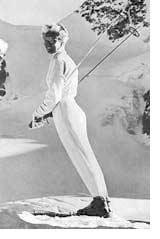Maria Bogner - Maria Bogner and the stretch pant
Maria Bogner introduces sex to skiing
By Seth Masia
It was fifty years ago. Maria Bogner spent the summer of 1952 figuring out how to cut the maddeningly stretchy new Helanca material to make sexy ski pants.
Bogner was already an established skiwear brand with a reputation for quality and durability. Willy Bogner, Sr., who competed in both alpine and Nordic events, apprenticed in Marius Eriksen’s ski shop in Oslo – according to Wolfgang Lert, he taught little Stein his first alpine turns. When Bogner returned to Germany, he brought back some Norwegian anoraks, and Maria ran off some copies for her friends. Just after World War II, Maria set up a sewing operation in some Quonset huts near the Austrian border, north of Kufstein. She did contract work, mass-producing such homely products as kitchen aprons.
By 1950, the Bogners had bought an old sauerkraut factory in Munich and begun making gabardine ski pants in the fashionable taper-leg “Keilhosen” (wedge-pants) style. The tough wool-blend twill didn’t stretch, but it wore like iron. The pants were expensive but lasted forever, and even became popular among Lappland miners – very much the way Levi Strauss’ denims had been popular a century earlier in the California gold fields. Maria’s first great innovation was to introduce brighter colors. Skiers were used to choosing among black, navy, gray and forest green. Maria offered them red, royal blue, brown and beige.
Like Levis, Bogner gabardines inspired knock-offs – Sam Roffe, for instance, began making gabardine ski pants in Seattle. Gabardine pants were warm and reasonably water repellent, but anyone who cared to ski fast – especially racers – understood the problem of baggy pants flapping in the wind. In America, the White Stag and Sun Valley skiwear companies began to experiment with new stretchy wool blends.
The first of the these blends was developed in Switzerland, in the early ’30s, by an American, Rudolph Kaegi. He spun the acetate fiber Celanese into a springy spiral, then wove it with wool to produce the first stretch fabric. The material was licensed and marketed by Heberlein & Co., under the brand name Helanca. The stuff worked, for a short while, but lost its stretch when washed. After World War II, nylon became available to European mills in commercial quantities. Heberlein redesigned Helanca using the new, more waterproof synthetic. It worked better, and stood up longer to laundering. This is the fabric Maria Bogner first saw in 1951. An even better version was developed in French mills in the late ’50s, using nylon threads coiled both to the left and to the right. Bogner’s first pants were made of the original Helanca nylon/wool blend, and while they looked great, they lost resilience within a couple of seasons.
Maria spent the better part of a year experimenting with patterns to make the pants fit properly. The new pants looked great, especially on athletic young women. The Bogner catalog featured stunning, leggy models, including Aspen’s Monica Brown and the sensational new champion Stein Eriksen. Bogner began shipping pants during the winter of 1952-53, and they were an instant hit, even at the sky-high price of $40.
By 1955, the U.S. importer, Hagemeister-Lert, had 42 different color swatches from which dealers could choose. The pants were made in a huge variety of sizes – all the usual waist sizes, with seven lengths each for men and women, from xx short to xx long. “It was important to get people to buy the pants short enough, so they wouldn’t bag at the knees,” Lert recalls.
Racers converted instantly. Aerodynamic legs simply made you faster. Beside, the pants were sexy as hell. The world’s top expert on looking good on snow, Warren Miller, once wrote “I credit the growth of skiing during those years (the ’50s and ’60s) to Maria Bogner and her invention of stretch ski pants. Let’s face it; sex sells. Anyone who was in reasonable shape could put on a pair of her stretch pants and look as sleek and attractive as someone in a James Bond movie.”
With the advent of stretch pants, it was often said, the sexual dynamic in skiing changed in a subtle way. Before Bogner, a woman who went skiing was assumed to be looking for a man (see, for instance, the plot line of Sun Valley Serenade, or the early work of ski humorists Abby Rand and Marti Sterling). After stretch pants, single men flocked to ski areas – and especially to ski area bars – to watch women (see Don Sauer’s Girl Watcher’s Guide, published in 1965).
Maria made herself a two-piece stretch suit, which had to be belted together around the waist. Threading the belt through alternating loops sewn to the pants and the tunic was time consuming, and she complained of having to watch her coffee intake before hitting the slopes. This is the outfit she modelled on the cover of a 1955 issue of Ski, leaning forward to show off the lovely line of her, umm, hips.
Standard rig for the fashionable skier in the late ’50s consisted of Bogner stretch pants and a light poplin jacket over a wool sweater. The poplin jacket could be embroidered, and Maria delighted in clean, elegant designs. She remained focused on high fashion, and was very late to recognize that hardy Americans wanted weatherproof parkas. “Jim Tobin used to beg her to give us higher collars,” Lert says.
Maria remained actively involved in skiwear design until her sons Michael and Willy, Jr., took over in the ’70s. The boys were endlessly creative. But no one would ever again have quite the impact on ski fashion as Maria’s simple, sleek-and-sexy stretch pants.

